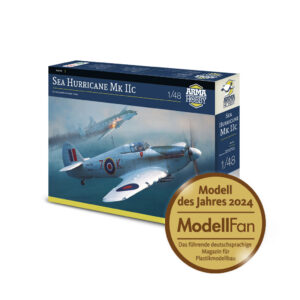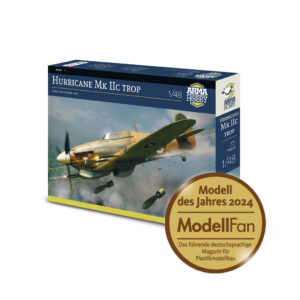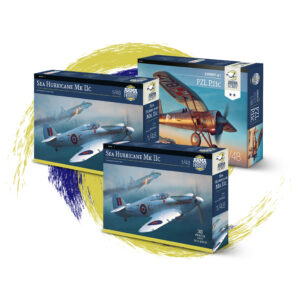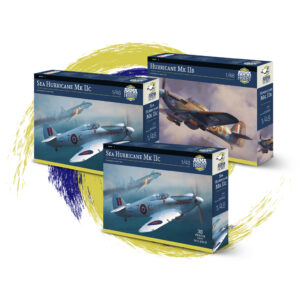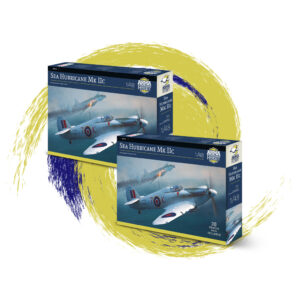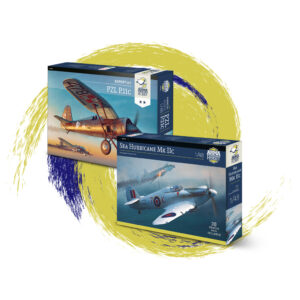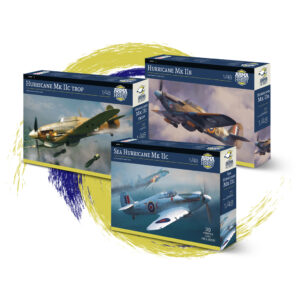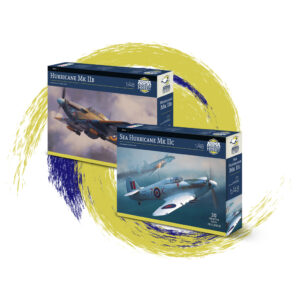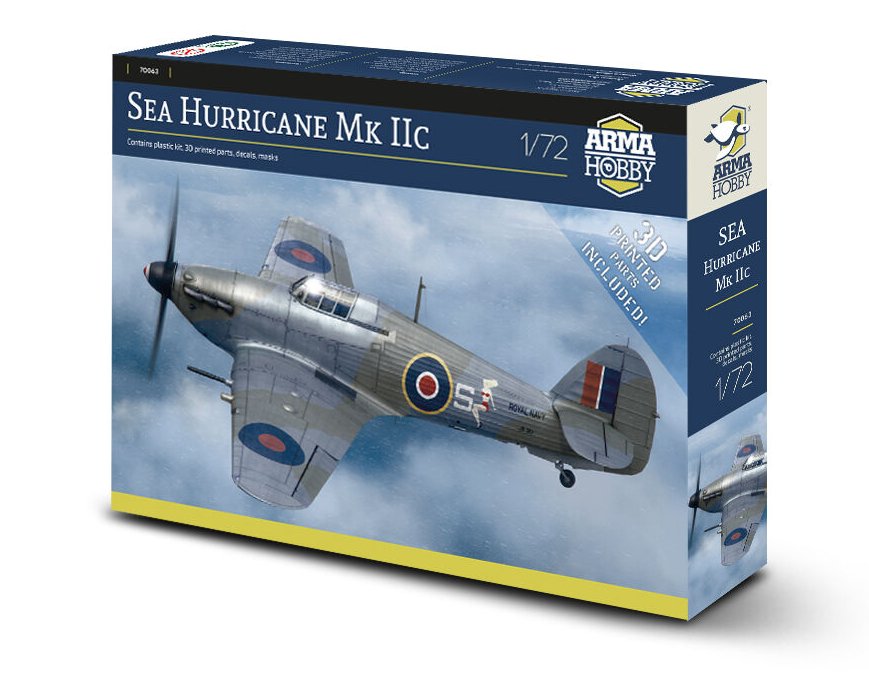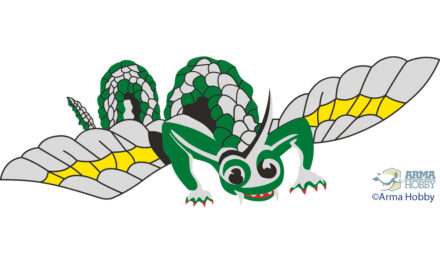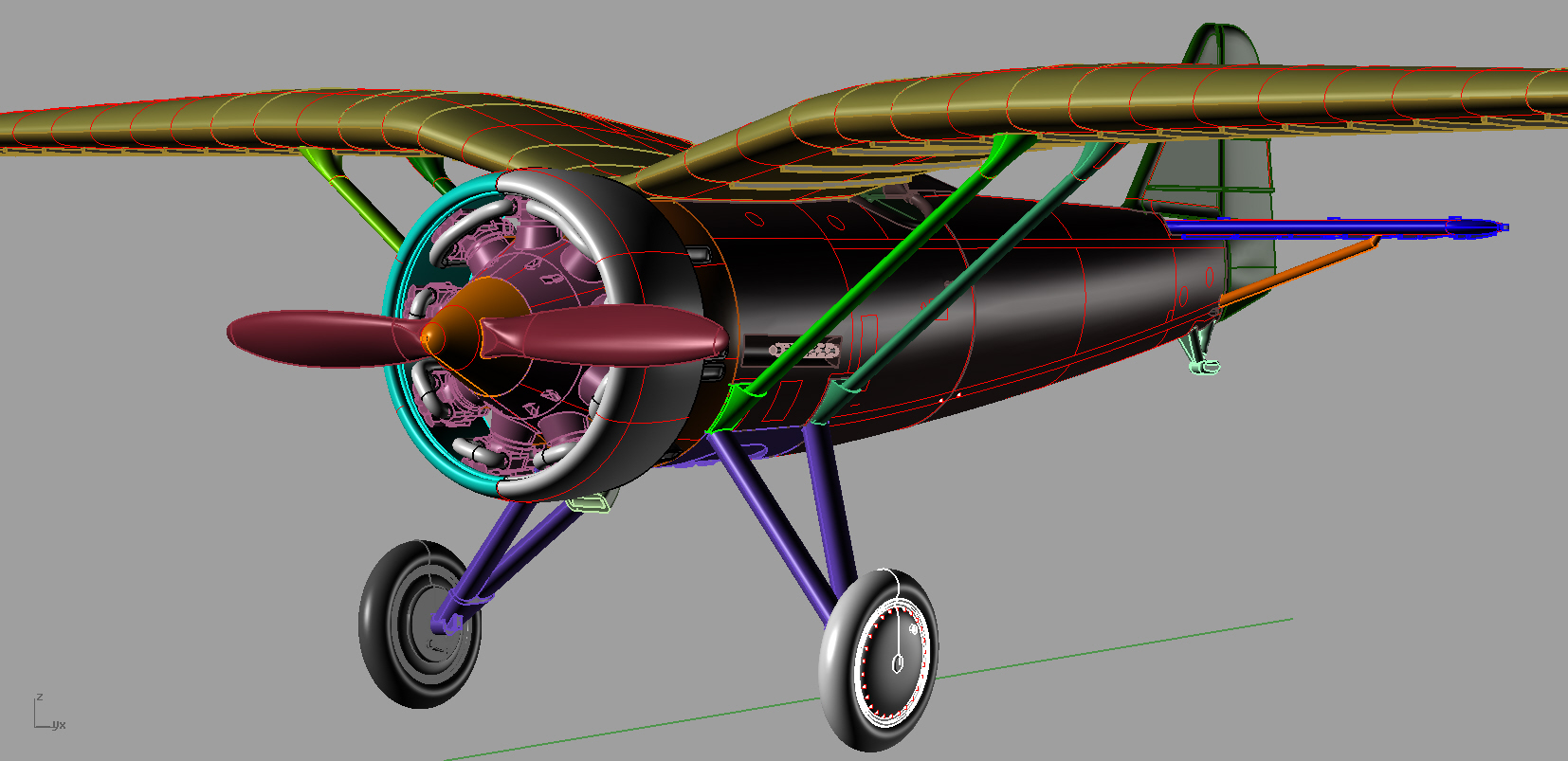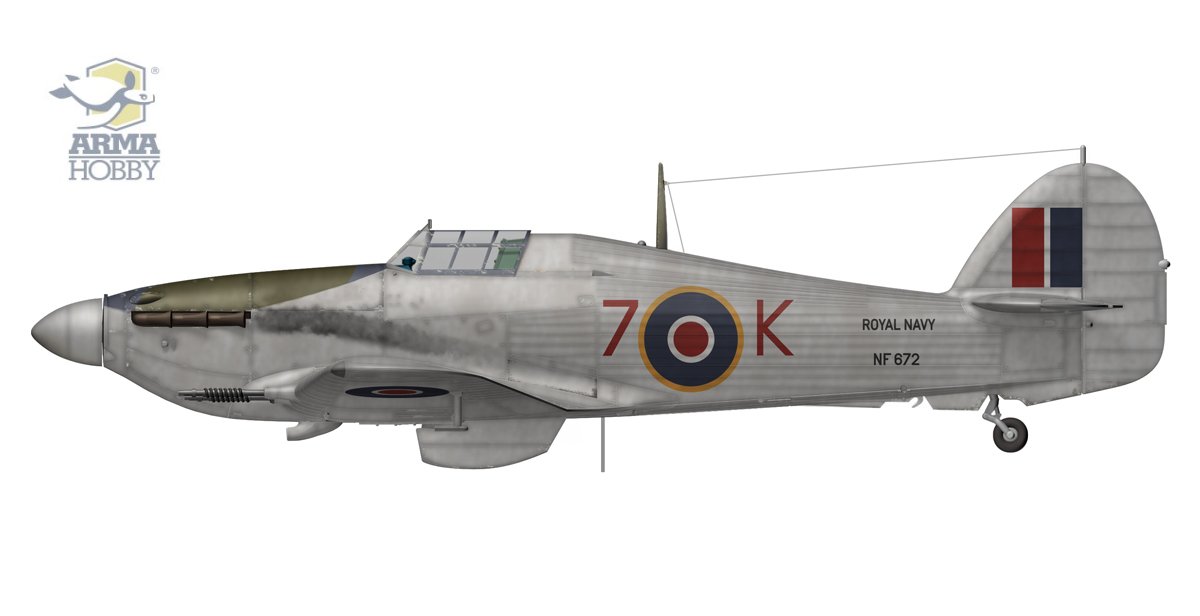 New Era
New Era
1943 was the year of gradual strengthening of the FAA and the period of decline of the Sea Hurricane. The British naval aviation was spreading its wings during the spring and summer, mainly with US aircraft types. At the beginning of September 1943, out of the 707 first-line FAA machines, 298 had come from the USA. The total included 339 first-line fighters, half of these manufactured in US factories. The Martlets/Wildcats were the most numerous at 117 (in nine squadrons), British Seafires in various versions were second (in eleven squadrons). By the autumn of 1943, the FAA operational units (thus not counting the reserves, numerous training and second-line formations, such as No. 877 Squadron, whose task was to defend the eastern coast of Africa) had only… 17 Sea Hurricanes!
All eighteen Sea Hurrie IICs of the newly reformed No. 800 Squadron flew in training off the deck of HMS ‘Unicorn’, a brand new auxiliary aircraft carrier (which replaced the aged ‘Argus’), over the Irish Sea on 24 March 1943. This team then worked together for almost a month. However, No. 800’s Sea Hurries failed to join HMS ‘Unicorn’ for the Royal Navy’s Operation ‘Governor’ into the Norwegian waters in July, meant to distract attention from the invasion of Sicily. By that time the squadron had started the process of re-equipment with the Hellcat, the first one to do so.

November 1943. From the deck of the escort aircraft carrier HMS Chaser, a Sea Hurricane IIC from 835 Squadron, bearing the individual letter Z, takes off for a training flight over the Irish Sea. Unfortunately, the serial number is unknown. After training on the Chaser, Sea Hurries of No. 835 Squadron found themselves on HMS Nairana – their destination ship – in December 1943. Photo: HMS Chaser Company
Escort carriers and Composite Squadrons
The times of escort carriers were coming, their air components consisting of composite squadrons that had six Swordfish biplanes for anti-submarine duties and six fighters: Martlets/Wildcats, Seafires or Sea Hurricane IICs. The latter had a huge advantage: a salvo of four 20 mm cannon was able to effectively silence the crew of a surfaced U-boat from a long distance, if the latter decided to engage the aeroplanes. And if German reconnaissance machines appeared over the Atlantic-traversing convoys or their supporting search and strike forces of aircraft carriers and anti-U-boat vessels, even old fighters with such cannon batteries were deadly dangerous against them. At the end of the summer of 1943, three squadrons equipped with Swordfish IIs and Sea Hurricane IICs were fighting at sea: Nos. 824, 825 and 835.
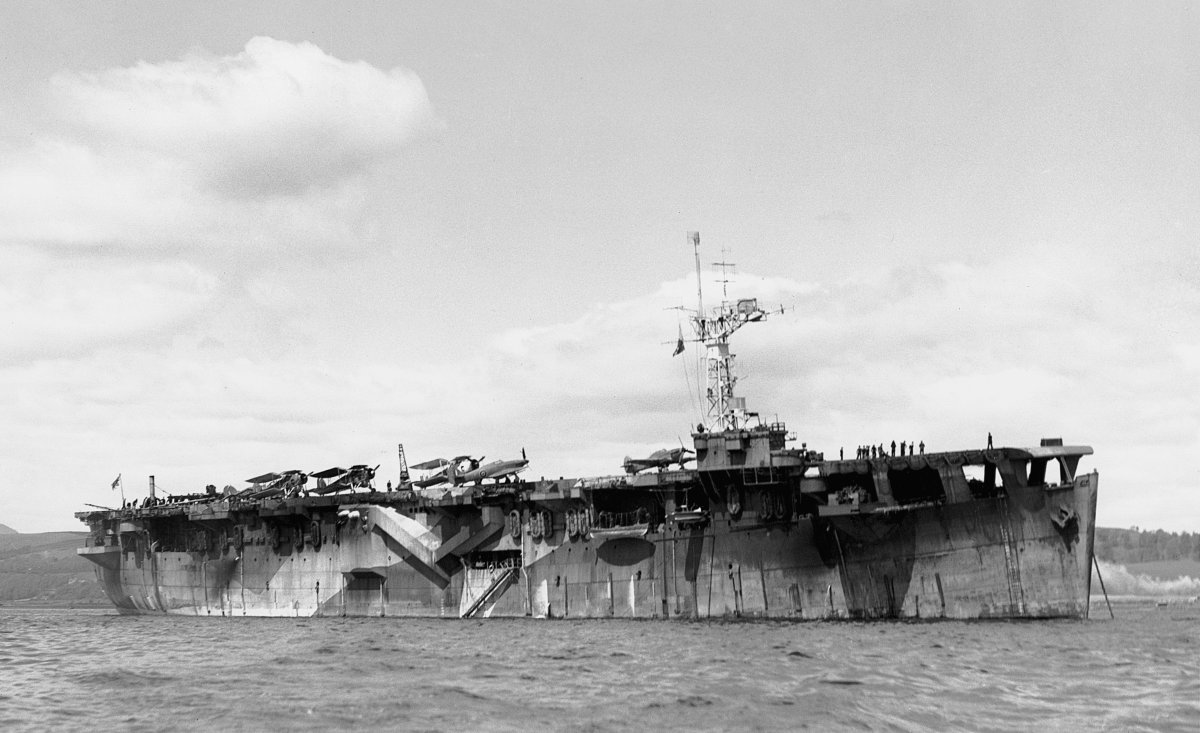
The escort carrier HMS Vindex earned the reputation of a U-boat scourge. Sea Hurricane IIC of No. 825 Squadron operated from its deck since December 1943. The second plane behind the island is a fighter marked with the letter P, armed with a battery of 4 rockets under the wings.
Photo: via Adam Jarski

The same Sea Hurricane IIC – “P” – takes off from the deck of HMS Vindex. The plane does not take off with open ammunition hatches. Their covers were replaced with ones painted with darker paint, hence the illusion of their absence. Photo: via Adam Jarski
In October 1943, No. 824 Composite Squadron was assigned to the escort carrier HMS ‘Striker’. In December, No. 825 Squadron was deployed to HMS ‘Vindex’. HMS ‘Nairana’ with No. 835 set sail in January 1944. The pilots had to work very hard, by day and by night, sometimes in extremely adverse weather.

HMS Nairana with the Sea Hurries IIC of No. 835 Squadron repainted in the characteristic Coastal Command white. Photo: via Adam Jarski
To fly and fight in extreme conditions
A pilot of Lt Cdr (A) A.H.D. Gough’s No. 825 Sqn came in to land no less than seven times, because the stern of the ship would rise up to 8 yards into the air in the stormy seas! A burning Swordfish with a wounded crew crashed on landing upon return to HMS ‘Vindex’ on 24 March 1944. The crew was rescued, but one of the depth charges they had on board exploded, killing one sailor and injuring another, and leaving a gaping hole, 1 by 2.5 yards, in the deck. During the two-week cruise in March, No. 825 Sqn Sea Hurricane pilots took off 36 times and spent a total of 46 hours in the air. On three occasions they took off at night, flying in the darkness for 1.5 hours. Success came on 15 March, the group sank the U-653. In May 1944, air crews from HMS ‘Vindex’ sank another U-boat, the U-765, in co-operation with frigates. However, Sub-Lt A.E. Martin had to bale out of his Sea Hurricane at 3,000 ft after his engine stopped suddenly. This was 14 miles away from the convoy. The pilot was picked up by sailors from the frigate HMS ‘Goodson’, but he died of hypothermia.

June 2, 1944, Sub Lt. J.W. Hayes of No. 824 Squadron crashed his Sea Hurricane IIC JS222 into a barrier of HMS Striker during landing. The plane is so dirty and covered with salt that the borders of the camouflage colours cannot be seen. Photo: via Adam Jarski
With rockets against the U-Boat
On 22 August 1944, pilots from HMS ‘Vindex’ were the last ones to use Sea Hurricane IIs in combat. The aircraft were specially modified for rocket attacks against submarines. The fighters of No. 825 Squadron had their two outboard cannon removed, and these could be replaced with external containers for radio markers dropped to mark the position of submerging vessels or two-rocket launchers.

Sea Hurricane IIC of No. 825 Squadron armed with rockets on board HMS Vindex. Note the saw-cut wheel covers. Photo: from the collection of Wojciech Łuczak
HMS ‘Vindex’ was protecting a convoy to Russia, and No. 825 Squadron was led by Sub-Lt (A) F.G.B. Sheffield. The situation became dramatic when the British formation was targeted by no less than five U-boats, so all pilots went into action. New Zealander Sub-Lt H.E. Moore, piloting BX126 / 2F, probably the last operational Sea Hurrie IIB, together with Sub-Lt W.A. Johnson in Mk IIC NF732 / 2H and Sub-Lt P.A. Hellyer in Mk IIC JS272 / 2Q, hit the surfaced German submarine with their rockets. They were only credited with heavily damaging, however.
Sweet S for Sugar
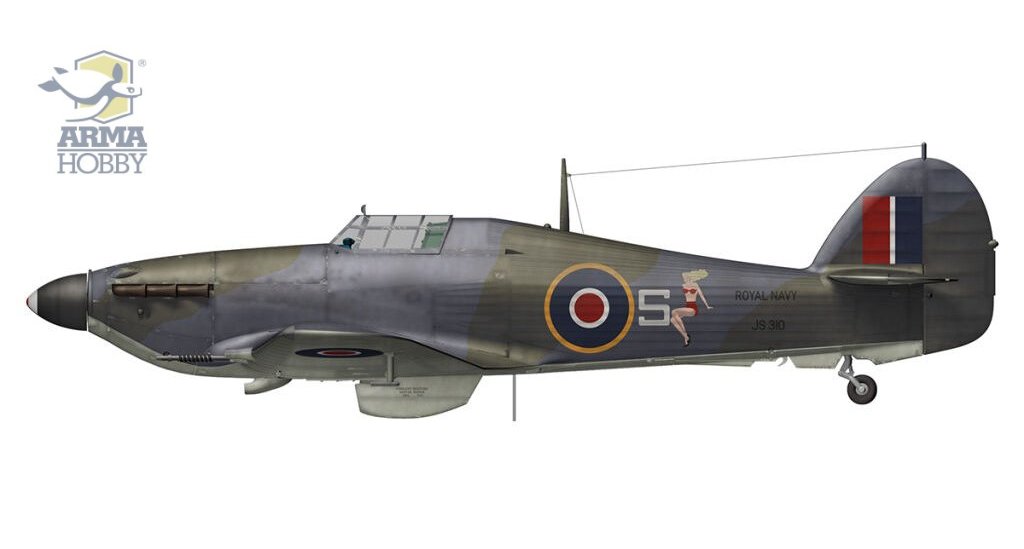
Sea Hurricane Mk IIc, JS310 “S” – No. 825 Squadron, HMS Vindex, early 1944
This plane, with a frivolous emblem very unusual for the conservative Royal Navy, is known from two photos, one of which we have the right to publish courtesy of Tony O’Toole, and from the second one, published in the magazine “Flypast” from December 2007, we show only a small fragment with the emblem and markings – fair use – right to quote.

The deck of HMS Vindex seen from the top of the mast. In the foreground S is for Sugar, i.e. Sea Hurricane IIC JS310 without painting on the right side of the fuselage and without rockets under the wings with only two cannons.
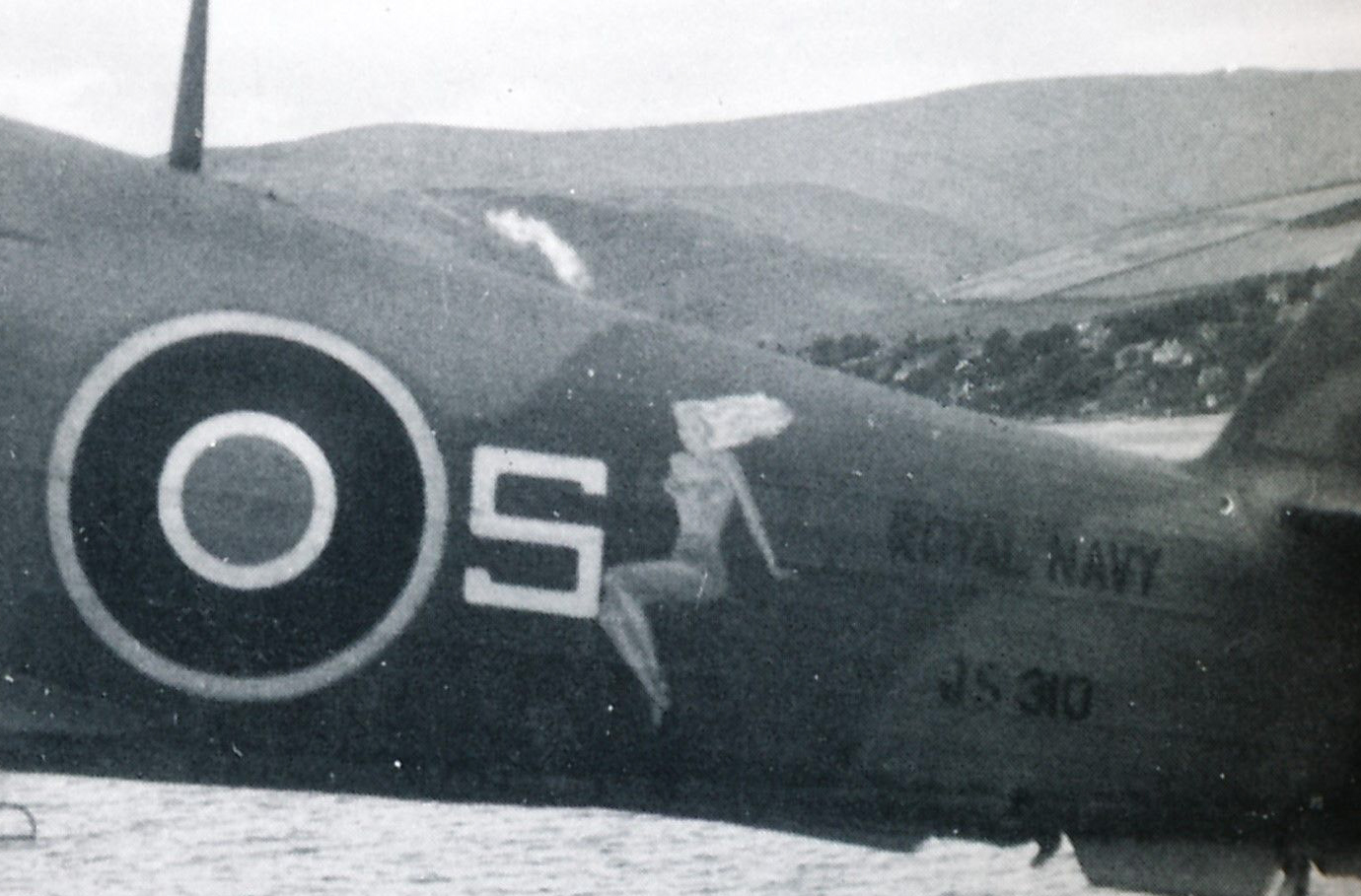
No. 824 Squadron under Lt Cdr (A) E.L. Russell was deployed aboard HMS ‘Striker’ on 27 October 1943. Six Sea Hurricane IICs had been delivered to the unit in August. In December, the carrier began its Atlantic convoy duty. By then, the famous Fw 200 Condors had been replaced above the ocean by the four-engine radar-equipped Ju 290As with strong defensive armament. The first interception of a Ju 290A by a Sea Hurrie from HMS ‘Striker’ took place on 9 January 1944. Sub-Lt J.W. Hayes attempted to shoot down the intruder, but only managed to chase it away. He had to return to the carrier due to strong vibrations of his fighter. In a tragic friendly fire incident, two Sea Hurrie IIC pilots from HMS ‘Striker’ shot down an American C-54 transport aircraft over the Atlantic in March, mistaking it for another Ju 290A.
The last air victories
In May 1944, HMS ‘Striker’ took part in Operation ‘Potluck’ in Norwegian waters. It is noteworthy that the escort of the two British aircraft carriers included two Polish destroyers: ORP ‘Piorun’ and ORP ‘Błyskawica’. Bomb-carrying Hellcats from Nos. 800 and 804 Squadrons aboard HMS ‘Emperor’ were to attack ships in Norwegian anchorages in the Nord-Trondelag area, and HMS ‘Striker’ was to provide aerial anti-submarine protection for the entire force. The whole operation was planned as a diversionary attack intended to distract the Germans from another air raid on the battleship ‘Tirpitz’ (eventually cancelled due to bad weather!) and to keep U-boats on alert in the Norwegian waters before the planned Normandy landings in June. Ten Wildcat Vs of No. 898 Squadron were also embarked on ‘Striker’. The operation commenced on 14 May in excellent weather. The Royal Navy force was detected by a patrolling Fw 200 Condor, which was only damaged by intervening Wildcats from ‘Striker’. Nevertheless, eighteen Hellcats were launched to attack the harbour of Rorvik as planned. They were led by No. 804 Sqn ‘skipper’, Lt Cdr Stanley Orr, the famous ace of aces of the Fleet Air Arm. The real effect was the destruction of five He 115 seaplanes (some in the air, some on the water). About 2 p.m., after the Hellcats were back on the deck of HMS ‘Emperor’ (one fighter was lost with the pilot), the force turned back west. A few hours later, the radar detected a formation of what was believed to be German torpedo bombers approaching at low altitude from the east, about 10 miles away. HMS ‘Striker’ positioned herself into the wind and No. 824 Sqn’s Green Section, two Sea Hurricane IICs at readiness, scrambled immediately, flown by Sub-Lt Steel and PO Blanco. They reached 2,000 feet, getting close already, and they were visually guided onto the enemy by observers on ships. It turned out that a formation of six Bf 110 twin-engined fighters was approaching. The Sea Hurries attacked.
The Germans tried to evade them by a port turn. A regular air combat began. Steel started firing from 1,000 yards. He was soon in trouble: the two outboard cannon had been removed from his machine and the starboard one that was left was now jamming. When he fired the port one alone, the aeroplane was becoming unstable and turned. At this point the Bf 110s split into two sections. Steel selected the one of four, which began to climb for the cloud cover. The British pilot focused on the starboard-most Bf 110 (it was difficult for him to catch up with the others) and started firing his cannon at it until it disappeared in the clouds. Blanco was flying about 100 yards behind the leader and managed to open fire from one side at the Bf 110s as they disappeared in the clouds. He could not see any hits. He remained below while Steel broke through the cloud cover but failed to encounter the Germans there. He circled above the clouds but saw no one. After returning to HMS ‘Striker’, it turned out that Steel’s aircraft had been hit in the starboard wing, most likely by a Bf 110 gunner, with the camera gun destroyed and the cannon damaged. A propeller blade was also shot through. Steel was adamant that he had at least damaged the Bf 110 before it entered the clouds. His claim was supported by sailors from light cruiser HMS ‘Royalist’, who observed smoke trailing behind one of the twin-engined fighters. Steel’s claim was also supported by the navy radio surveillance on the Luftwaffe frequency, which picked up a report (interpreted by an ex-Swiss cook!) from an aeroplane west of Orlandet that it was having serious difficulty returning to the base. We have a detailed account of this penultimate Sea Hurricane air battle thanks to the work of Bengt Standvik, a Norwegian historian, published in the December 2017 issue (No. 46) of ‘Flyhistorie’ magazine.

June 7, 1944 Sub Lt. E.C. Gulden from No. 824 Squadron in cockpit of “R” – NF674, with the characteristic Sea Hurricane landing jump, flew over the arresting cable and ended up on the arresting barrier of HMS Striker. The landing gear and propeller were damaged. “R” was the hero of Operation Potluck on May 14, 1944, when piloted by Sub Lt. Oliver Steel – leader of the Green Section – took part over Norwegian waters in repelling an attack by at least six Bf 110s and probably shooting down one. Photo: HMS Striker Company
However, the last successful Sea Hurricane IIC actions against Luftwaffe aircraft, in late May 1944, were fought by No. 835 Squadron fighters from HMS ‘Nairana’. At that time, the carrier was protecting convoys from Gibraltar to Britain. New Zealander Sub-Lt C.W.G. Richardson, flying JS304, was first guided onto a reconnaissance Ju 290B of Fernauklaerungsgruppe 5 from Mont de Marsan, a base south of Bordeaux, on 25 May. All he achieved was to chase the spying aircraft away from the convoy. The next morning the same pilot, in JS304 again, together with another New Zealander, Sub-Lt A.R. ‘Al’ Burgham, intercepted another Ju 290B at 47°03’N 18°27’W. They fired one after another, but suddenly Richardson’s aeroplane was hit by German gunners at 7.20 a.m. and crashed into the water. His body was picked up by HMS ‘Highlander’. Meanwhile, Al in his NF672 fired decisive bursts at the German, who went down into the water in flames. The Germans sent two more Ju 290B reconnaissance aeroplanes from Bordeaux a few hours later. At 4.15 p.m. one of these was shot down at 41°33’N 18°37’W by a pair of Sea Hurricane IICs: Sub-Lt Mearns in NF698 / 7D and Sub-Lt F. Wallis in JS248. Five German air crew members were picked up from the ocean by HMS ‘Inglis’. The British claimed another four-engine aeroplane probably destroyed. The Germans admitted the loss of two reconnaissance bombers by FAGr.5 in the area.
White Hurricanes from HMS Nairana
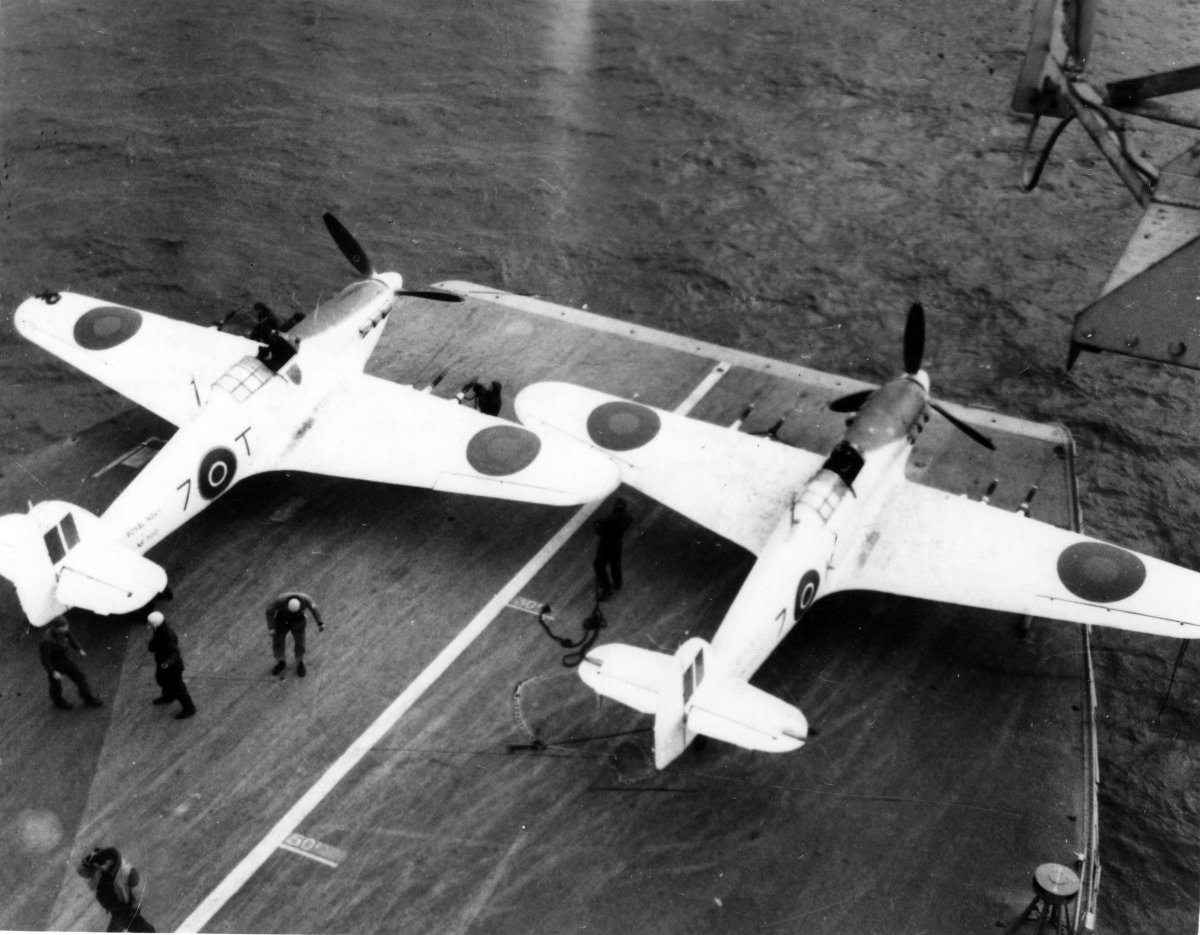
“7T” – NF700 and “7K” – NF672 on the forward part of the flight deck of the escort carrier HMS Nairana. The first one ended its life on March 2, 1944, when it broke almost into two parts after hard landing. The plywood cockpit door with the emblem of tiger’s head, retained from the time of service in 804 NAS, was then installed on “7K”. The latter – with a downed Ju 290 – had a crash on the ship’s barrier at the end of June while returning from a flight from Gibraltar. Photo: via Adam Jarski
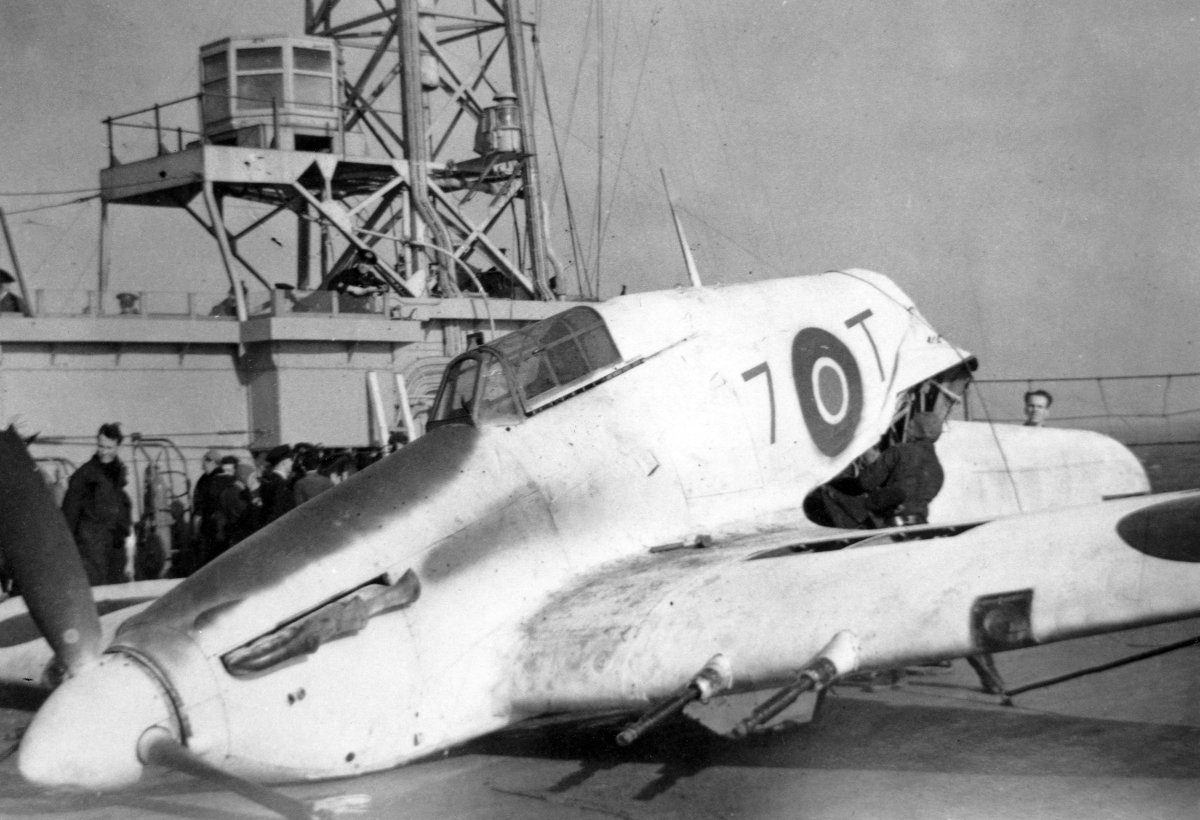
After such a crash, the wreck of “7T” was pushed into the water on March 2, 1944. This was witnessed by the crew of Polish destroyer ORP Burza, protecting the escort carrier Nairana and convoy OS.69/KMS.43 to Gibraltar. Photo: via Adam Jarski
From the memoirs of Sea Hurricane IIC pilot of the No. 835 Squadron – New Zealander Allen Burgham, written by his son Ian Burhgam (The Story of “Nicky”), it appears that the unique white camouflage of the squadron’s fighters was applied to the standard sea camouflage of Royal Navy aircraft in early 1944 (in the photo it wasn’t there yet in February). The initiator was the commander of the HMS Nairana air group – Edgar Bibby. The originator’s intention was to blend the Sea Hurricane perfectly into the clouds covering the sky over Atlantic Ocean.
The pilots embraced the idea. And most importantly – it was also accepted by the aircraft carrier’s commander – Commander R.M.T. Taylor. Provided, however, that this is against the Admiralty’s regulations for painting fighters and all this needs to be consulted with the Admiralty. But, as Burgham remembers – the winner of the duel with the Ju 290 – no one cared much about it and within one day the whole fighters, apart from the panel in front of the windscreen, were covered with Atlantic white.

NF 672 “Nicki” in the camouflage and marking carried in May 1944, when it shot down Junkers four-motor patrol plane
From the Editor: In June 1944, NF 672, like many other aeroplanes, received invasion bands, which were later partially painted over (on the upper surfaces and the fuselage). There seems to be no consensus regarding the painting of the bottom of this particular specimen. It is known that the Hurricanes on HMS Nairana were painted white on all surfaces, and it is also known that some of them could have had left their undersides in Sky colour due to shortage of paint. After analysing the photos we know, we concluded that our example was most likely originally painted all white. Later the invasion stripes on the upper surfaces (wings and/or fuselage?) were painted over with fresh white paint, which resulted in the difference in shades of white visible in the photo. The leading edge of the wing was also repainted, overlapping the bottom up to the first panel line. We reproduced this effect in the scheme presented in the model kit instructions.
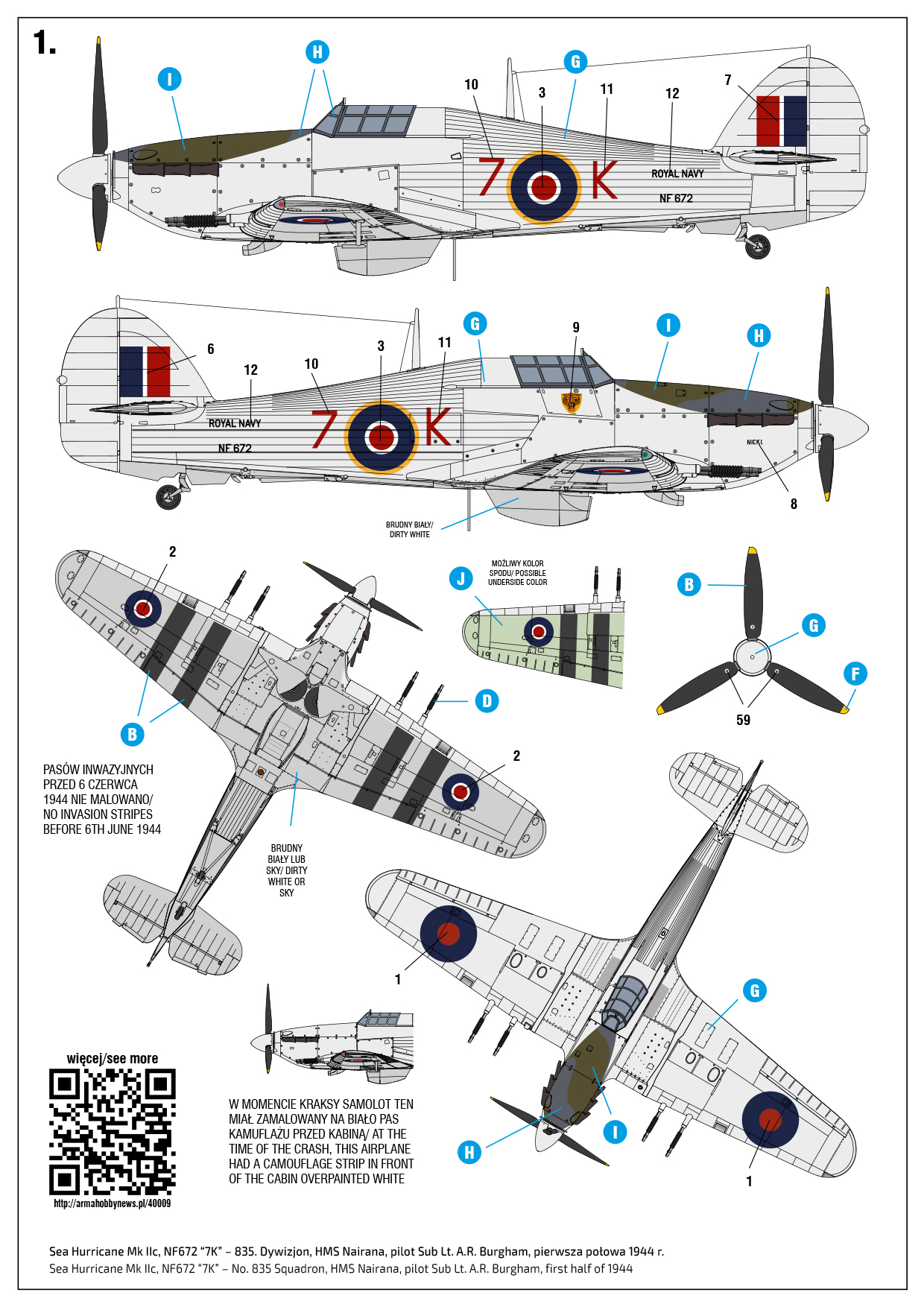
Photo of Hurricane “7K – Nicki” crashed by Sub Lt. Ken Atkinson – with the name “Nicki” and emblem visible, is available on the Allen Burgham memoir website..
No. 835 Squadron finally parted with its long-serving Sea Hurricane IICs on 28 September 1944, at Machrihanish, a Fleet Air Arm base southwest of Glasgow, Scotland. It received four Wildcat VIs to as replacements.

That was most probably the ultimate finale in the combat career of the type which in 1941–42, during the most difficult period for the Allies, had turned out to be Royal Navy fighter arm’s saviour hurricane that protected it from the worst.
English translation of the article: Wojtek Matusiak. English translation of photo captions: Grzegorz Mazurowski
Medal Promotion for 1/48 models
Starting today, you can pre-order Sea Hurricane Mk IIc and other Hurricanes and PZL P.11c in 1/48 scale in the Medal Promotion with a large discount and in promotional bundles. The bigger the bundle, the bigger the discount!
Pre-ordered kits will be shipped from March 15.
- See all the Medal Promotion Bundles in the Armahobby.com online and order some for yourself!
Buy 1/72 Sea Hurricane IIc online at the Armahobby.com!
See also:
Currently Defense Analyst. Journalist with more than 30 years of experience in defence reporting from fields of conflicts (Afghanistan, Balkans). Known from TV live commentaries on different contemporary defense and security issues. With catapult launches and arresting landings on the board of USS Saratoga and flights in the rear cockpit of F/A-18 D Hornet in his log book. Devoted scale modeller and great fan of naval aviation.
This post is also available in:
 polski
polski


